Aquila (bird)
| Aquila Temporal range: Middle Miocene to present
| |
|---|---|

| |
| Golden eagle (Aquila chrysaetos) | |
| Scientific classification | |
| Kingdom: | Animalia |
| Phylum: | Chordata |
| Class: | Aves |
| Order: | Accipitriformes |
| Family: | Accipitridae |
| Subfamily: | Aquilinae |
| Genus: | Aquila Brisson, 1760 |
| Type species | |
| Aquila chrysaetos Linnaeus, 1758
| |
| Synonyms | |
and see text | |
Aquila is the genus of true eagles. The genus name is Latin for "eagle", possibly derived from aquilus, "dark in colour".[1] It is often united with the buteos, sea eagles, and other more heavyset Accipitridae, but more recently they appear to be less distinct from the more slender accipitrine hawks than previously believed. Eagles are not a natural group, but denote essentially any bird of prey large enough to hunt sizeable (about 50 cm long or more overall) vertebrate prey.
Taxonomy and systematics[]
The genus Aquila was introduced by the French zoologist Mathurin Jacques Brisson in 1760 with the golden eagle (Aquila chrysaetos) as the type species.[2][3] Aquila belongs to a close-knit group of "typical" eagles including genera Hieraaetus, Lophaetus, Ictinaetus, Clanga, and the extinct Harpagornis. This group occurs as a clade within the larger group of "booted" eagles (tribe Aquilini or subfamily Aquilinae).[4]
The plumage of the more basal members of the booted-eagle group, such as Spizaetus and Nisaetus, generally has barred underparts in adults, and is distinctly different in juveniles which have plain, pale underparts. In contrast, within the Aquila–Hieraaetus–Lophaetus clade, adults are generally dark, with juveniles more closely resembling the adults. Hieraaetus species have both dark and light (or "pied") morphs, with the latter having light, unbarred under-parts.[5]
Research in molecular genetics found Aquila and Hieraaetus to be polyphyletic. Between 2005 and 2014, the British Ornithologists' Union included both Bonelli's and the booted eagle in Aquila. Also, Clements' Checklist merged all Hieraetus species into Aquila from 2001 to 2009. The current approach is to keep Hieraaetus as a separate genus, with Bonelli's eagle and the African hawk-eagle moved into Aquila and Wahlberg's eagle moved into Hieraaetus.[6]
The spotted eagles greater spotted eagle, lesser spotted eagle, and Indian spotted eagle (previously Aquila clanga, A. pomarina, A. (p.) hastata) are thought to be genetically closer to Ictinaetus and Lophoaetus than to other Aquila species, and may be placed into a separate genus, Clanga.[4]
Members of Aquila (excluding those moved to Clanga and Hieraaetus, but including A. fasciata/spilogaster) share two deletions in the (nuclear) LDH gene, as well as similarities in mitochondrial cyt-B gene sequence, though one of these deletions is reverted in A. chrysaetos.[5]
Species[]
The genus Aquila contains 11 species:[7]
| Common name | Scientific name [a] | IUCN Red List Status | Distribution | Picture | ||
|---|---|---|---|---|---|---|
| Status | Trend | Population[b] | ||||
| Bonelli's eagle | Aquila fasciata (Vieillot, 1822) |
LC IUCN[8] | 20,000 - 49,999 | 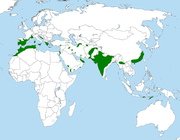
|
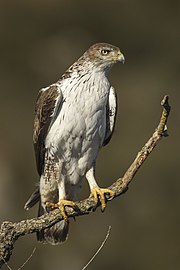
| |
| Cassin's hawk-eagle | Aquila africana (Cassin, 1865)[5] |
LC IUCN[9] | 670 - 6,700 | 
| ||
| African hawk-eagle | Aquila spilogaster (Bonaparte, 1850) |
LC IUCN[10] | 
|

| ||
| Golden eagle | Aquila chrysaetos (Linnaeus, 1758) |
LC IUCN[11] | 100,000 - 200,000 | 
|
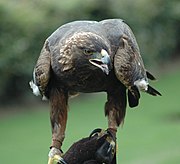
| |
| Eastern imperial eagle | Aquila heliaca Savigny, 1809 |
VU IUCN[12] | 2,500 - 9,999 | 
|

| |
| Spanish imperial eagle | Aquila adalberti C. L. Brehm, 1861 |
VU IUCN[13] | 970 | 
|

| |
| Steppe eagle | Aquila nipalensis (Hodgson, 1833) |
EN IUCN[14] | 50,000 - 75,000 | 
|

| |
| Tawny eagle | Aquila rapax (Temminck, 1828) |
VU IUCN[15] | 100,000 - 499,999 | 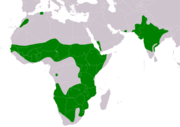
|

| |
| Verreaux's eagle | Aquila verreauxii Lesson, 1830 |
LC IUCN[16] | 
|
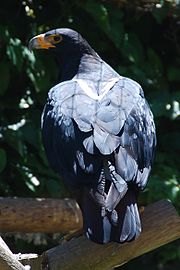
| ||
| Gurney's eagle | Aquila gurneyi Gray, 1860 |
NT IUCN[17] | 
| |||
| Wedge-tailed eagle | Aquila audax (Latham, 1801) |
LC IUCN[18] | 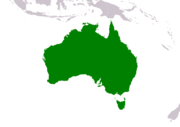
|

| ||
Fossil record[]
Numerous fossil taxa of eagles have been described.[19][20] Many have been moved to other genera, but several appear to be correctly assigned to this genus:
- Aquila bullockensis (Middle Miocene)
- ? (Middle/Late Miocene of , France)
- ? (Middle/Late Miocene of Grive-Saint-Alban, France)
- Aquila sp. (Late Miocene – Late Pliocene of S Europe)[20]
- Aquila sp. (Early Pliocene of Florida)
- (Late Pliocene of S USA)
- Aquila kurochkini (Late Pliocene of Varshets, Bulgaria)[21]
- Aquila sp. (Middle Pleistocene of Castiglione, Corsica)[22]
- ? (Middle/Late Pleistocene of Monte Reale, Sardinia)
- Aquila nipaloides (Pleistocene of Sardinia and Corsica)[23]
- ?Aquila sp. (Late Quaternary, Madagascar)[24]
Whether "Hieraaetus" edwardsi (Middle -? Late Miocene of SW Europe) belongs into Aquila or the hawk-eagles (if the latter are indeed distinct) is unclear. Its initial name, "Aquila" minuta Milne-Edwards, 1871, is preoccupied by a junior synonym of the booted eagle, A. minuta Brehm, 1831.
Not placed in Aquila anymore are:
- "Aquila" gervaisii – now in Palaeohierax
- "Aquila" borrasi, "A." sodalis – now in Buteogallus, B. borrasi was long placed in Titanohierax.
- "Aquila" pliogryps – now in Spizaetus
- "Aquila" corroyi, "A." depredator, "A." hypogaea, and "A." prisca – now in
- "Aquila" ferox, "A." lydekkeri – protostrigid owls, now in Minerva.
"Aquila" danana (Snake Creek Late Miocene/Early Pliocene of , USA), occasionally placed in Geranoaetus or Buteo, was a bird of prey of unclear relationships.
Notes[]
- ^ A binomial authority in parentheses indicates that the species was originally described in a genus other than Aquila.
- ^ Estimate for the number of mature individuals in the wild.
References[]
- ^ Jobling, James A (2010). The Helm Dictionary of Scientific Bird Names. London: Christopher Helm. p. 52. ISBN 978-1-4081-2501-4.
- ^ Brisson, Mathurin Jacques (1760). Ornithologie, ou, Méthode Contenant la Division des Oiseaux en Ordres, Sections, Genres, Especes & leurs Variétés (in French and Latin). Paris: Jean-Baptiste Bauche. Vol. 1, p. 28, Vol. 1, p. 419.
- ^ Mayr, Ernst; Cottrell, G. William, eds. (1979). Check-list of Birds of the World. Volume 1 (2nd ed.). Cambridge, Massachusetts: Museum of Comparative Zoology. p. 378.
|volume=has extra text (help) - ^ Jump up to: a b Boyd, John Accipitriformes", Taxonomy in Flux Checklist.
- ^ Jump up to: a b c Helbig, AJ; Kocum, A; Seibold, I; Braun, MJ (2005). "A multi-gene phylogeny of aquiline eagles (Aves: Accipitriformes) reveals extensive paraphyly at the genus level" (PDF). Molecular Phylogenetics and Evolution. 35 (1): 147–164. doi:10.1016/j.ympev.2004.10.003.
- ^ See article Hieraaetus for details.
- ^ Gill, Frank; Donsker, David, eds. (2019). "New World vultures, Secretarybird, kites, hawks, eagles". World Bird List Version 9.1. International Ornithologists' Union. Archived from the original on 24 April 2020. Retrieved 2 April 2019.
- ^ BirdLife International (2015). "Aquila fasciata". IUCN Red List of Threatened Species. 2015. Retrieved 12 April 2015.
- ^ "Aquila africana". IUCN Red List of Threatened Species. Retrieved 31 October 2016.
- ^ BirdLife International (2012). "Aquila spilogaster". IUCN Red List of Threatened Species. 2012. Retrieved 2 November 2016.
- ^ BirdLife International (2013). "Aquila chrysaetos". IUCN Red List of Threatened Species. 2013. Retrieved 2013-11-26.
- ^ BirdLife International (2017). "Aquila heliaca". IUCN Red List of Threatened Species. 2017: e.T22696048A117070289. doi:10.2305/IUCN.UK.2017-3.RLTS.T22696048A117070289.en.
- ^ BirdLife International (2013). "Aquila adalberti". IUCN Red List of Threatened Species. 2013. Retrieved 26 November 2013.
- ^ BirdLife International (2015). "Aquila nipalensis". IUCN Red List of Threatened Species. 2015. Retrieved 24 January 2016.
- ^ BirdLife International (2018). "Aquila rapax". IUCN Red List of Threatened Species. 2018. Retrieved 17 December 2018.
- ^ BirdLife International (2016). "Aquila verreauxii". IUCN Red List of Threatened Species. 2016: e.T22696067A95221980. doi:10.2305/IUCN.UK.2016-3.RLTS.T22696067A95221980.en.CS1 maint: uses authors parameter (link)
- ^ BirdLife International (2012). "Aquila gurneyi". IUCN Red List of Threatened Species. 2012. Retrieved 26 November 2013.
- ^ BirdLife International (2012). "Aquila audax". IUCN Red List of Threatened Species. 2012. Retrieved 26 November 2013.
- ^ Brodkorb, Pierce (1964). "Catalogue of Fossil Birds: Part 2 (Anseriformes through Galliformes)". Bulletin of the Florida State Museum. 8 (3): 195–335.
- ^ Jump up to: a b Mlíkovský, Jirí (2002): Cenozoic Birds of the World, Part 1: Europe Archived 2011-03-07 at WebCite . Ninox Press, Prague, p. 194.
- ^ Boev, Z., 2013. Aquila kurochkini sp. n., a New Late Pliocene Eagle (Aves, Accipitriformes) from Varshets (NW Bulgaria). - Paleontological Journal, 2013, Vol. 47, No. 11, pp. 1344–1354. Pleiades Publishing, Ltd., 2013.
- ^ Salotti, Michelle; Bellot-Gourlet, Ludovic; Courtois, Jean-Yves; et al. (2000). "La fin du Pléistocène supérieur et le début de l'Holocène en Corse: apports paléontologique et archéologique du site de Castiglione (Oletta, Haute-Corse)" [The end of the Late Pleistocene and the Early Holocene in Corsica: New paleontological and archaeological data from Castiglione deposit (Oletta, Haute-Corse)]. Quaternaire (English abstract) (in French). 11 (3): 219–230. doi:10.3406/quate.2000.1671.
- ^ Louchart, Dr Antoine; Bedetti, Claudia; Pavia, Dr Marco (2005-05-10). "A new species of eagle (Aves: Accipitridae) close to the Steppe Eagle,from the Pleistocene of Corsica and Sardinia,France and Italy". Palaeontographica Abteilung A (in German): 121–148.
- ^ Madagascar and other Islands. Human Settlers Invade Paradise Archived 2007-10-07 at the Wayback Machine. Endangered Species Handbook. Retrieved on 2013-04-17.
External links[]
 Media related to Aquila at Wikimedia Commons
Media related to Aquila at Wikimedia Commons
- Aquila (genus)
- Bird genera
